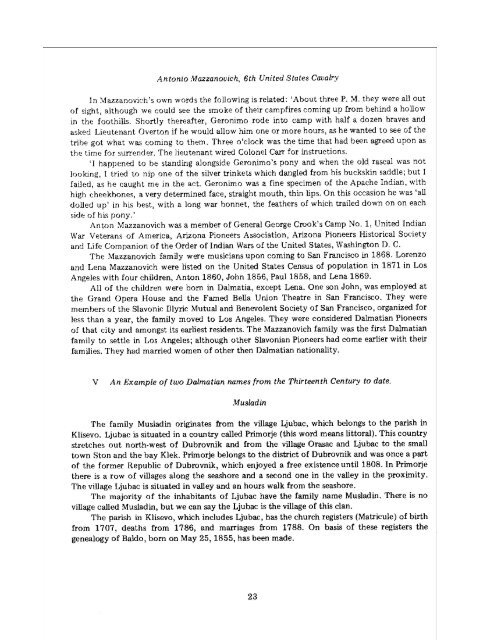Yugoslavia
Yugoslavia
Yugoslavia
Create successful ePaper yourself
Turn your PDF publications into a flip-book with our unique Google optimized e-Paper software.
Antonio Mazzanovich, 6th United States Cavalry<br />
In :\lazzanovich's own words the following is related: 'About three P. :\l. they were all out<br />
of sight, although we could see the smoke of their campfires coming up from behind a hollow<br />
in thc foothills. Shortly thereafter, Geronimo rode into camp with half a dozen braves and<br />
asked Lieutenant Overton if he would allow him one or more hours, as he wanted to see of the<br />
tribe got what was coming to them. Three o'clock was the time that had been agreed upon as<br />
the time for surrender. The lieutenant wired Colonel Carr for instructions.<br />
'I happened to be standing alongside Geronimo's pony and when the old rascal was not<br />
looking, I tried to nip one of the silver trinkets which dangled from his buckskin saddle; but I<br />
failed, as he caught me in the act. Geronimo was a fine specimen of the Apache Indian, with<br />
high cheekbones, a very determined face, straight mouth, thin lips. On this occasion he was 'all<br />
dolled up' in his best, with a long war bonnet, the feathers of which trailed down on on each<br />
side of his pony.'<br />
Anton Mazzanovich was a member of General George Crook's Camp No.1, United Indian<br />
War Veterans of America, Arizona Pioneers Association, Arizona Pioneers Historical Society<br />
and Life Companion of the Order of Indian Wars of the United States, Washington D. C.<br />
The Mazzanovich family were musicians upon coming to San Francisco in 1868. Lorenzo<br />
and Lena Mazzanovich were listed on the United States Census of population in 1871 in Los<br />
Angeles with four children, Anton 1860, John 1856, Paul 1858, and Lena 1869.<br />
All of the children were born in Dalmatia, except Lena. One son John, was employed at<br />
the Grand Opera House and the Famed Bella Union Theatre in San Francisco. They were<br />
members of tbe Slavonic lllyric Mutual and Benevolent Society of San Francisco, organized for<br />
less than a year, the family moved to Los Angeles. They were considered Dalmatian Pioneers<br />
of that city and amongst its earliest residents. The Mazzanovich family was the first Dalmatian<br />
family to settle in Los Angeles; although other Slavonian Pioneers had come earlier with their<br />
families. They had married women of other then Dalmatian nationality.<br />
V An Example of two Dalmatian names from the Thirteenth Century to date.<br />
Musladin<br />
The family Musladin originates from the village Ljubac, which belongs to the parish in<br />
Klisevo. Ljubac is situated in a country called Primorje (this word means littoral). This country<br />
stretches out north-west of Dubrovnik and from the village Orasac and Ljubac to the small<br />
town Ston and the bay Klek. Primorje belongs to the district of Dubrovnik and was once a part<br />
of the former Republic of Dubrovnik, which enjoyed a free existence until 1808. In Primorje<br />
there is a row of villages along the seashore and a second one in the valley in the proximity.<br />
The village Ljubac is situated in valley and an hours walk from the seashore.<br />
The majority of the inhabitants of Ljubac have the family name Musladin. There is no<br />
village called Musladin, but we can say the Ljubac is the village of this clan.<br />
The parish in Klisevo, which includes Ljubac, has the church registers (Matricule) of birth<br />
from 1707, deaths from 1786, and marriages from 1788. On basis of these registers the<br />
genealogy of Baldo, born on May 25, 1855, has been made.<br />
23


